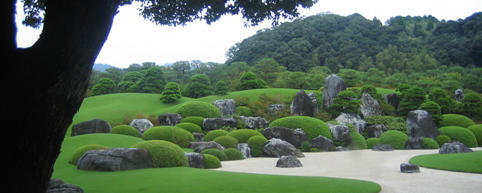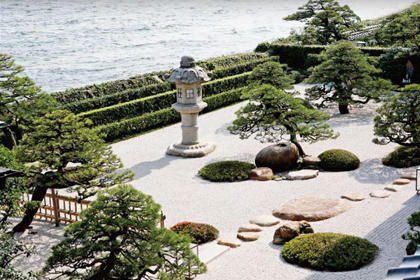
At a glance
Sanin (pronounced San-in) is situated on the western part of the mainland Japan along the Sea of Japan. There are many old and historic towns in this area, with a diversity of tradition and culture. Matsue, Izumo, and Iwami Ginzan (silver mine)
are the most popular destinations in Sanin area.
Highlights
Matsue

Matsue, a castle town along Shinjiko Lake, boasts a flourishing of culture and art. Matsue Castle built in 1611 is surrounded by a water-filled moat. Small excursion boats on the moat will take you to Samurai residences, old streets and the home of a British writer Lafcadio Hearn, famous for "Kwaidan (Ghost Story)".
Fumaiko, the lord of Matsue domain, was devoted to "Chanoyu", the ritual for serving and drinking Japanese tea, and established Chanoyu culture in Matsue. Delicate Japanese confectionaries for tea made in Matsue is popular natiowide.
Please see our special article on the top gardens in Shimane (in and near Matsue area in particular) that we hope will inspire you to explore this fascinating area of Japan.
Izumo

Izumo is recognized for various mythologies. With the history of over 1,500 years, Izumo Shrine, known as the god of marriage and luck, is said to be the most powerful shrine in Japan. Walking along the pine tree road and passing the bronze shrine gate, the front shrine will show up with a huge twisted straw ropes hanging over the entrance. The main shrine is a sacred area for prayers. According to a mythology, October is the month when Gods from other parts of Japan
gather to Izumo Shrine. In the old days, October was called "Kamiarizuki " meaning "the month with gods" in Izumo. On the other hand, it was called "Kannazuki" meaning "the month without gods" in other parts of Japan. For gourmet travelers, Izumo Soba is recommended. The stone-grounded husked buckwheat noodles are served in dishes with different garnishes.
Iwami Ginzan (Silver Mine)

Iwami Ginzan, the UNESCO World Heritage site newly registered in 2007, used to be a silver mining town between 16th and 20th centuries. The high quality of silver, which acoounted for one third of the silver production in the world, once attracted Europeans to this small town. The area covers many labyrinths of mines under investigation, small ports for the silver shipment to foreign countries, temples to pray for mine workers' spirits, and picturesque towns. Curretly Ryugenji Mabu (mine tunnel) is opened for public, and the narrow tunnel reveals the back-breaking hand work of mine workers. It is said that their longevity after becoming a worker was only four years. In the spring of 2008, another mine tunnel, Okubo Mabu, will be opened for public.
Access
There are a variety of approaches to this area. Typical routes are as follows:
From Tokyo
- Tokyo - [1 hr. 30 min. by flight] - Yonago or Izumo
- Tokyo - [6 hr. 30 min. by bullet train & limited express] - Matsue or Izumo
From Osaka
- Osaka - [1 hr. by flight] - Izumo
- Osaka - [3 hr. 30 min. by bullet train & limited express] - Matsue Izumo
Recommended Accommodations
These are a few hotels that we recommend. We can book other ryokans or hotels depending on your travel plan or budget. Please contact us by E-mail (commentsmtj@michitravel.com) or phone (81-3-523-5040).
 Minamikan(Matsue)
Minamikan(Matsue)